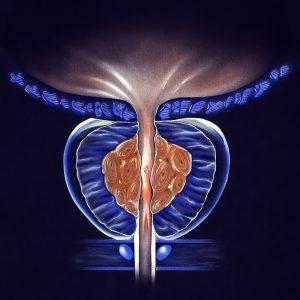Prostate gland enlargement is a common condition that affects older men, ages 40 to 60 years old. The medical term for an enlarged prostate is called Benign Prostatic Hyperplasia (BPH).
 When it comes to the signs and symptoms, the patient usually experiences increased nighttime urination, weak urine stream, or difficulty starting urination. Also, the patient may experience an inability to urinate, urinary tract infection, or blood in the urine.
When it comes to the signs and symptoms, the patient usually experiences increased nighttime urination, weak urine stream, or difficulty starting urination. Also, the patient may experience an inability to urinate, urinary tract infection, or blood in the urine.
In this post, you’ll learn more about enlarged prostate, including its causes and treatment.
What Causes An Enlarged Prostate and How It Is Diagnosed
The exact cause of an enlarged prostate is unknown. It’s believed that one factor that causes BPH is male sex hormonal changes that come with aging. Also, your risk of having an enlarged prostate increases if you have testicular abnormalities or a family history of BPH and other prostate problems.
BPH can be diagnosed through physical examination – rectal examination – and obtaining your medical history. The rectal examination involves checking the shape and size of your prostate.
Here are the tests to rule out prostate gland enlargement:
- Urinalysis: Examination of the urine for the presence of bacteria and blood.
- Prostatic biopsy: The removal of sample-sized prostate tissue and examined for any abnormalities.
- Urodynamic test: It checks the pressure in the urinary bladder during urination.
- Prostate-specific antigen (PSA) test: It refers to a blood test that evaluates prostate gland enlargement. If the substance produced by the prostate gland (prostate-specific antigen) has abnormally increased, then it’s indicative of BPH.
- Post-void residual: It examines the amount of urine left in the urinary bladder after urination.
- Cystoscopy: It involves the examination of bladder and urethra using a small lighted scope.
- Intravenous pyelography: This is a CT scan or X-ray exam that’s done after injecting a dye into the body to highlight the entire urinary system. It creates images so the doctor can determine abnormalities in the prostate gland.
How To Treat Prostate Gland Enlargement
Treating an Enlarged Prostate with Medication
Before any invasive treatment procedure is considered, doctors usually advise patients to undergo medications and dietary supplements, such as Prostagenix. Many patients experience great relief from uncomfortable signs and symptoms of BPH, allowing them to enjoy an improved quality of life.
Here are some of the most common medications for mild to moderate symptoms of BPH:
- Alpha-blockers: Urination is made easier by taking this medication. It’s because alpha blockers relax the prostate muscle fibers and the neck of the urinary bladder. One of the side effects of alpha-blockers includes dizziness.
- 5-alpha reductase inhibitors: The prostate gland is shrunk with the help of this drug (finasteride or dutasteride), which prevents hormonal changes causing prostate growth.
- Combination drug therapy: If either medication is not effective, the doctor might recommend combining both drug therapy.
Minimally Invasive Treatment Procedures
If you have moderate to severe BPH, surgical therapy, which is usually minimally invasive, is highly recommended. Some of the most common conditions wherein patients seek a definitive treatment is they have bladder stones, urinary tract obstruction, or kidney problems.
Here are some examples of surgical therapies:
- Transurethral Resection of the Prostate or TURP: The surgeon removes the outer part or external portion of the prostate gland with the aid of a lighted scope. This procedure quickly relieves the symptoms. Most patients have a stronger flow of urine after the procedure. You might need a catheter, temporarily, to drain your urinary bladder after the procedure.
- Transurethral Incision of the Prostate or TUIP: Small cuts are created in the prostate gland with the aid of a lighted scope inserted into the urethra. In that way, the urine can easily pass through the urethra.
- Transurethral Microwave Thermotherapy or TUMT: It shrinks and eases urine flow. A special electrode with microwave energy is inserted through the urethra until it reaches the prostate area to destroy the inner part of the prostate gland.
- Transurethral Needle Ablation or TUNA: The surgeon places needles into the prostate gland, and radio waves are passed to heat and eventually destroy excess tissue of the enlarged prostate gland, which blocks urine flow. However, this procedure is rarely used nowadays.
- Laser Therapy: It involves using a high-energy laser to destroy and remove overgrown prostate tissue. With laser therapy, it generally relieves signs and symptoms right away with lesser side effects than non-laser treatments.
Conclusion
Prostate gland enlargement should not be overlooked. The signs and symptoms may disrupt you from pursuing your normal daily activities, including your career, hobbies, and travels.
Of course, it’s best to undergo non-invasive procedures first, like taking medications and dietary supplements. In that way, you won’t suffer from side effects associated with surgical therapies.

